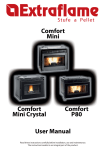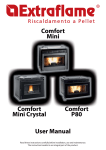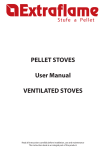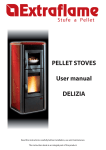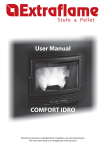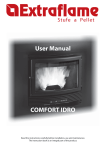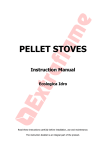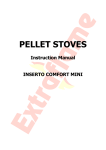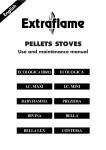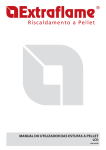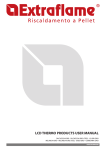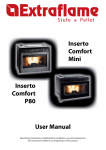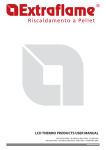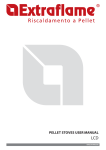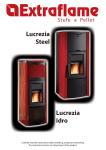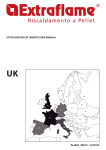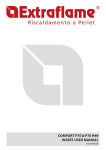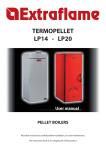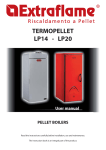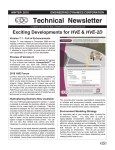Download PELLET STOVES User Manual VENTILATED STOVES
Transcript
Stufe a Pellet PELLET STOVES User Manual VENTILATED STOVES Read all instructions carefully before installation, use and maintenance The instruction book is an integral part of the product. 2 Congratulations! You are now the owner of an EXTRAFLAME stove! The EXTRAFLAME pellet stove is an ideal heating solution. It utilises the most advanced technology and is manufactured to the highest standards with a contemporary design, allowing you to enjoy the ambience and warmth of a natural flame in complete safety. This manual tells you how to use your stove correctly. Please read the entire manual carefully before using your stove. IMPORTANT Make sure that the dealer completes the following box with the details of the authorised specialist who will help you if you have any problems in using your new pellet stove. AUTHORISED SPECIALIST COMPANY __________________________________________________________________ Full name __________________________________________________________________ Address ______________________________________________ No. __________________ Postal Code ____________ City __________________ County. ______________________ TEL. ________________________________ FAX __________________________________ All Extraflame products are manufactured according to the following directives: 89/106 CEE (Construction Products) 89/366 CEE (EMC Directive) 2004/108 CE (EMC Directive) 2006/95 CE (Low Voltage Directive) And the following standards: EN 14785 EN 60335-1 EN 60335-2-102 EN 61000-3-2 EN 61000-3-3 EN 50366 EN 55014-1 EN 55014-2 3 4 Index Chapter 1 PRECAUTIONS AND SAFETY .................................................................................................................... 7 Chapter 2 TECHNICAL FEATURES ............................................................................................................................. 8 Chapter 3 WHAT ARE PELLETS?............................................................................................................................... 11 PELLET STORAGE .................................................................................................................................................................. 11 PELLET LOAD .......................................................................................................................................................................... 11 Chapter 4 SAFETY DEVICES ..................................................................................................................................... 12 WARM AIR BLOWER BREAKDOWN ................................................................................................................................ 12 FUME EXHAUSTER BREAKDOWN ................................................................................................................................... 12 PELLET FEED MOTOR BREAKDOWN ............................................................................................................................. 12 LIGHTING FAILURE ............................................................................................................................................................... 12 TEMPORARY POWER FAILURE ......................................................................................................................................... 12 ELECTRICAL SAFETY ............................................................................................................................................................ 12 EXHAUST FUME SAFETY ................................................................................................................................................... 12 PELLET OVERHEATING SAFETY ...................................................................................................................................... 12 Chapter 5 ASSEMBLY AND INSTALLATION INSTRUCTIONS................................................................................. 13 GLOSSARY ............................................................................................................................................................................... 13 INSTALLATION........................................................................................................................................................................ 14 ADMISSIBLE INSTALLATIONS .................................................................................................................................... 14 PROHIBITED INSTALLATIONS .................................................................................................................................... 14 CONNECTION TO THE EXHAUST VENTING SYSTEM ............................................................................................... 15 EXHAUST CHANNEL OR PIPE .................................................................................................................................... 15 CHIMNEY OR SINGLE FLUE ........................................................................................................................................ 16 CONNECTION TO THE FLUE AND COMBUSTION PRODUCT EXHAUST VENTING ................................ 18 CHIMNEY CAP ................................................................................................................................................................. 18 CONNECTION TO EXTERNAL AIR INTAKES ................................................................................................................. 19 INSULATION, TRIMS, FACINGS, AND SAFETY PRECAUTIONS.............................................................................. 19 NATIONAL, REGIONAL, PROVINCIAL AND MUNICIPAL LAWS ............................................................................ 19 Chapter 6 DIVINA PLUS DISTRIBUTED HEATING .................................................................................................. 20 DIVINA PLUS ........................................................................................................................................................................... 20 TOSCA PLUS ............................................................................................................................................................................ 20 Chapter 7 COMFORT MAXI INSTALLATION ............................................................................................................ 21 MOUNTING ON EXISTING BASE ...................................................................................................................................... 21 INSTALLATION WITH PEDESTAL (OPTIONAL) ............................................................................................................ 22 EXTRACTING THE INSERT .................................................................................................................................................. 23 FITTING THE FRAMES .......................................................................................................................................................... 23 RECIRCULATION AIR PIPES ............................................................................................................................................... 24 Chapter 8 FALO’ 1XLP, FALO’ 1CP AND FALO’ 2CP ................................................................................................. 28 5 Chapter 9 PRODUCT FUNCTIONING ....................................................................................................................... 29 CONTROL PANEL ................................................................................................................................................................... 29 CURRENT TIME AND DAY SETTINGS ............................................................................................................................. 30 FUNCTIONING CYCLE ......................................................................................................................................................... 30 BASIC INSTRUCTIONS .................................................................................................................................................. 30 LIGHTING........................................................................................................................................................................... 31 NORMAL OPERATION ................................................................................................................................................... 31 SHUTDOWN ..................................................................................................................................................................... 32 Chapter 10 REMOTE CONTROL (OPTIONAL “ROSY“) .............................................................................................. 33 Chapter 11 ROOM THERMOSTAT .............................................................................................................................. 34 DIGITAL THERMOSTAT (INCLUDED) .............................................................................................................................. 34 MECHANICAL THERMOSTAT (OPTIONAL) .................................................................................................................. 34 INSTALLING A MECHANICAL THERMOSTAT (OPTIONAL)..................................................................................... 34 MECHANICAL THERMOSTAT WITH STANDBY FUNCTION (CAN BE USED WITH TELEPHONE ACTUATOR) ............................................................................................................................................................................. 34 MECHANICAL THERMOSTAT OPERATION FOR HEAT DISTRIBUTION MOTOR (DIVINA PLUS ONLY) ... 35 Chapter 12 USER PARAMETERS ................................................................................................................................ 36 WEEKLY PROGRAMMER ..................................................................................................................................................... 36 DAY/NIGHT TEMPERATURE FUNCTION ....................................................................................................................... 39 PELLET FEED ADJUSTMENT ............................................................................................................................................. 40 HEAT DISTRIBUTION MOTOR PARAMETERS .............................................................................................................. 41 Chapter 13 STOVE CLEANING.................................................................................................................................... 42 ECOLOGICA – COMFORT MAXI ....................................................................................................................................... 42 BELLA – BELLA LUX – DUCHESSA – DUCHESSA STEEL – CONTESSA – CLEMENTINA – DIVINA – DIVINA STEEL – DIVINA PLUS – TOSCA PLUS CLEANING ..................................................................................................... 44 PULIZIA BABYFIAMMA – PREZIOSA – KAROLINA – ISABELLA – GRAZIOSA – ROSY ................................. 46 FALÒ 1XLP – FALÒ 1CP – FALÒ 2CP – ESMERALDA CLEANING.......................................................................... 48 BURN POT PARTITION ......................................................................................................................................................... 50 CHIMNEY CONNECTION .................................................................................................................................................... 50 Chapter 14 TABLE OF DISPLAY MESSAGES .............................................................................................................. 51 Chapter 15 WARRANTY .............................................................................................................................................. 54 Chapter 16 QUALITY CONTROL ................................................................................................................................. 56 6 Chapter 1 PRECAUTIONS AND SAFETY The stoves manufactured in our factory are built with the maximum dedication to the individual components so as to protect both the user and the installer from accidents. Authorized personnel are therefore advised to pay special attention to the electrical connections after any servicing operation on the product, especially with regard to the stripped part of the wires, which must not protrude in any way from the terminal block to prevent possible contact with the live parts of the wire. Installation must be carried out by authorized personnel, who must issue the purchaser a declaration of compliance of the system. The purchaser shall assume responsibility for the definitive installation and consequent proper operation of the product installed. It is imperative to consider all national, regional, provincial and communal laws and norms in the country where the stove is installed. Extraflame S.p.A. may not be held responsible in the event of failure to observe these precautions. This instruction manual constitutes an integral part of the product. It must always accompany the appliance, also when it is transferred to another owner or user or moved to another location. If the manual gets damaged or lost, ask your local service centre for another copy. This stove must only be used for the applications for which it was expressly designed. The manufacturer declines any responsibility, contractually or extra-contractually, for any damage caused to persons, animals or property by errors in installation, adjustment, and maintenance, or by improper use. After removing the packaging, check to make sure that the contents are intact and complete. If this is not the case, contact the vendor from whom the appliance was purchased. The electrical components of the stove must only be replaced with original spare by an authorized service centre. PRECAUTIONS AND SAFETY General stove maintenance must be carried out at least once a year, scheduled sufficiently in advance with the service centre. The following safety precautions must be observed: Do not allow the stove to be used by unattended children or disabled persons. Do not touch the stove if you are bare-footed or if parts of your body are wet or damp. Modifying the safety or adjustment devices without the manufacturer’s approval or instructions is forbidden. Never pull, detach, or twist the electrical cables coming out of the stove, even if it is disconnected from the electrical power. Do not plug or reduce the size of the air vents of the room in which the stove is installed. The air vents are critical for correct combustion. Keep the packaging materials out of the reach of children and unattended disabled persons. During normal functioning of the product the door of the furnace must always be closed. Avoid direct contact with parts of the appliance, which tend to heat up during functioning. Check for the presence of any obstructions before switching the appliance on following a long standstill period. The stove has been designed to function in any climatic conditions (even critical), in particularly adverse conditions (strong wind, freezing) safety systems may intervene, which switch the stove off. If this happens, contact the after-sales service and do not disable the safety systems in any case. If the flue should catch fire use adequate systems to suffocate the flames or request help from the fire brigade. 7 Chapter 2 Preziosa Steel Isabella Rosy Karolina Graziosa Bella Bella Lux Weight Height Width Depth Diameter of fume discharge pipe Diameter of air intake pipe Max. heating volume Max. global thermal power Max. thermal power needed - air power supply - water power supply Min. thermal power needed Min. useful thermal power - air power supply - water power supply Max. fuel combustion per hour Min. fuel consumption per hour Tank capacity Recommended chimney draught Chimney draught at max. useful thermal power Chimney draught at min. useful thermal power Nominal electrical power Appliance electric power Nominal voltage Nominal frequency Diameter of water intake/output pipe Diameter of automatic discharge pipe Pump head Max. working water pressure allowed U.M. Preziosa Features Babyfiamma TECHNICAL FEATURES kg mm mm mm mm mm m3 kW kW kW kW kW kW kW kW kg/h kg/h kg Pa Pa Pa W W Vac Hz “ “ m bar 98 860 438 503 80 50 126 6.0 5.5 5.5 2.8 2.6 2.6 1.2 0.6 ~ 11 ~ 10 12 10 300 300 230 50 - 103 887 446 498 80 50 126 6.0 5.5 5.5 2.8 2.6 2.6 1.2 0.6 ~ 11 ~ 10 12 10 300 300 230 50 - 103 921 446 498 80 50 126 6.0 5.5 5.5 2.8 2.6 2.6 1.2 0.6 ~ 11 ~ 10 12 10 300 300 230 50 - 95 864 455 497 80 50 115 5.8 5.0 5.0 3.0 2.5 2.5 1.2 0.6 ~ 11 ~ 10 12 10 300 300 230 50 - 90 863 452 493 80 50 115 5.8 5.0 5.0 3.0 2.5 2.5 1.2 0.6 ~ 11 ~ 10 12 10 300 300 230 50 - 115 1021 488 510 80 50 161 8.0 7.0 7.0 2.8 2.6 2.6 1.6 0.6 ~ 15 ~ 10 12 10 300 300 230 50 - 115 1036 494 498 80 50 161 8.0 7.0 7.0 2.8 2.6 2.6 1.6 0.6 ~ 15 ~ 10 12 10 300 300 230 50 - 134 1041 520 582 80 50 172 8.8 7.5 7.5 3.5 3.0 3.0 1.8 0.7 ~ 25 ~ 10 12 10 300 300 230 50 - 137 1043 520 582 80 50 172 8.8 7.5 7.5 3.5 3.0 3.0 1.8 0.7 ~ 25 ~ 10 12 10 300 300 230 50 - The tank capacity depends on the type of pellet used. Tests carried out using wooden pellets as fuel, with heating power of 4.9 kW/h/kg. The data stated above is a reference and not binding. The manufacturer reserves the right to carry out any modifications in order to improve the performance of the product. The electrical power of the appliance indicates the sum of the electrical absorption of the components present, as per standard, inside the product. The nominal power is the maximum power value that the appliance can absorb also considering the installation of various additional devices. 8 TECHNICAL FEATURES Comfort Maxi Contessa Falò 1XLP Falò 1CP Falò 2CP Tosca Plus Weight Height Width Depth Diameter of fume discharge pipe Diameter of air intake pipe Max. heating volume Max. global thermal power Max. thermal power needed - air power supply - water power supply Min. thermal power needed Min. useful thermal power - air power supply - water power supply Max. fuel combustion per hour Min. fuel consumption per hour Tank capacity Recommended chimney draught Chimney draught at max. useful thermal power Chimney draught at min. useful thermal power Nominal electrical power Appliance electric power Nominal voltage Nominal frequency Diameter of water intake/output pipe Diameter of automatic discharge pipe Pump head Max. working water pressure allowed U.M. Duchessa Steel Features Duchessa Chapter 2 kg mm mm mm mm mm m3 kW kW kW kW kW kW kW kW kg/h kg/h kg Pa Pa Pa W W Vac Hz “ “ m bar 150 1032 538 541 80 50 200 10.0 8.7 8.7 3.8 3.4 3.4 2.0 0.8 ~ 25 ~ 10 12 10 300 300 230 50 - 138 1032 538 541 80 50 200 10.0 8.7 8.7 3.8 3.4 3.4 2.0 0.8 ~ 25 ~ 10 12 10 300 300 230 50 - 132 606 640 717 80 50 205 10.0 8.9 8.9 3.8 3.4 3.4 2.0 0.8 ~ 28 ~ 10 12 10 300 300 230 50 - 147 1068 522 547 80 50 242 12.0 10.5 10.5 3.8 3.4 3.4 2.5 0.8 ~ 21 ~ 10 12 10 300 300 230 50 - 302 1522 950 618 80 50 204 10.0 8.9 8.9 3.8 3.5 3.5 2.0 0.7 ~ 32 ~ 10 12 10 300 300 230 50 - 361 1522 1806 800 80 50 204 10.0 8.9 8.9 3.8 3.5 3.5 2.0 0.7 ~ 32 ~ 10 12 10 300 300 230 50 - 361 1522 1806 800 80 50 204 10.0 8.9 8.9 3.8 3.5 3.5 2.0 0.7 ~ 32 ~ 10 12 10 300 300 230 50 - 170 1150 560 568 80 50 253 12.0 11.0 11.0 3.8 3.6 3.6 2.5 0.8 ~ 24 ~ 10 12 10 300 300 230 50 - The tank capacity depends on the type of pellet used. Tests carried out using wooden pellets as fuel, with heating power of 4.9 kW/h/kg. The data stated above is a reference and not binding. The manufacturer reserves the right to carry out any modifications in order to improve the performance of the product. The electrical power of the appliance indicates the sum of the electrical absorption of the components present, as per standard, inside the product. The nominal power is the maximum power value that the appliance can absorb also considering the installation of various additional devices. TECHNICAL FEATURES 9 Clementina Divina Divina Steel Divina Plus Irina Ecologica Weight Height Width Depth Diameter of fume discharge pipe Diameter of air intake pipe Max. heating volume Max. global thermal power Max. thermal power needed - air power supply - water power supply Min. thermal power needed Min. useful thermal power - air power supply - water power supply Max. fuel combustion per hour Min. fuel consumption per hour Tank capacity Recommended chimney draught Chimney draught at max. useful thermal power Chimney draught at min. useful thermal power Nominal electrical power Appliance electric power Nominal voltage Nominal frequency Diameter of water intake/output pipe Diameter of automatic discharge pipe Pump head Max. working water pressure allowed U.M. Esmeralda Crystal Features Esmeralda Chapter 2 kg mm mm mm mm mm m3 kW kW kW kW kW kW kW kW kg/h kg/h kg Pa Pa Pa W W Vac Hz “ “ m bar 188 1011 1249 656 80 50 204 10.0 8.9 8.9 3.8 3.5 3.5 2.0 0.7 ~ 26 ~ 10 12 10 300 300 230 50 - 178 1011 1249 656 80 50 204 10.0 8.9 8.9 3.8 3.5 3.5 2.0 0.7 ~ 26 ~ 10 12 10 300 300 230 50 - 137 1068 500 573 80 50 242 12.0 10.5 10.5 3.8 3.4 3.4 2.5 0.8 ~ 25 ~ 10 12 10 300 300 230 50 - 175 1150 610 593 80 50 242 12.0 10.5 10.5 3.8 3.4 3.4 2.5 0.8 ~ 30 ~ 10 12 10 300 300 230 50 - 149 1150 610 593 80 50 242 12.0 10.5 10.5 3.8 3.4 3.4 2.5 0.8 ~ 30 ~ 10 12 10 300 300 230 50 - 190 1165 610 593 80 50 242 12.0 10.5 10.5 3.8 3.4 3.4 2.5 0.8 ~ 30 ~ 10 12 10 400 400 230 50 - 140 1053 522 559 80 50 242 12.0 10.5 10.5 3.8 3.4 3.4 2.5 0.8 ~ 21 ~ 10 12 10 300 300 230 50 - 159 955 667 671 80 50 237 12.0 10.3 10.3 3.8 3.4 3.4 2.5 0.8 ~ 35 ~ 10 12 10 300 300 230 50 - The tank capacity depends on the type of pellet used. Tests carried out using wooden pellets as fuel, with heating power of 4.9 kW/h/kg. The data stated above is a reference and not binding. The manufacturer reserves the right to carry out any modifications in order to improve the performance of the product. The electrical power of the appliance indicates the sum of the electrical absorption of the components present, as per standard, inside the product. The nominal power is the maximum power value that the appliance can absorb also considering the installation of various additional devices. 10 TECHNICAL FEATURES Chapter 3 WHAT ARE PELLETS? Pellets are made by applying very high pressure to sawdust; i.e. the residue of raw timber (without paint) produced by sawmills, carpentry works and other activities involved in processing wood. This type of fuel is completely environmentally friendly, as no binders of any kind are used to keep it compact. In fact, the compactness of the pellets over time is guaranteed by lignite, a natural substance found in the wood itself. As well as being an environmentally friendly fuel, since wood residues are exploited to the maximum, pellets also have technical advantages. While the heating power of wood is 4.4 kW/kg (with 15% humidity, after about 18 months seasoning), the power of pellets is 5.3 kW/kg. The density of the pellet is 650kg/m3 and the water content is 8% of its weight. For this reason, pellets do not need to be seasoned to obtain a sufficient heating yield. Pellets used must be compliant with norms: Ö-Norm M 7135 DIN plus 51731 UNI CEN/TS 14961 Extraflame recommends using 6 mm pellets. WARNINGS!!! THE USE OF OUT OF DATE PELLETS OR ANY OTHER MATERIAL, DAMAGES YOUR STOVES’ FUNCTIONS AND CAN DETERMINE THE END OF THE WARRANTY AND THE PRODUCER’S ANNEXED RESPONSIBILITY. PELLET STORAGE To guarantee problem-free combustion, the pellets must be stored in a dry place. PELLET LOAD To load the pellets, open the tank cover positioned on the upper part of the stove and empty the bag of pellets, paying attention not to let them escape. For the Inserto Comfort Maxi model consult the “Inserto Comfort Maxi Installation” chapter. figure 3.1 For Falò models consult the “Falò 1XLP, Falò 1CP and Falò 2CP” chapter”. WHAT ARE PELLETS? 11 Chapter 4 SAFETY DEVICES WARM AIR BLOWER BREAKDOWN If the blower stops for any reason, the stove automatically shuts down to prevent overheating. FUME EXHAUSTER BREAKDOWN If the exhauster stops, the electronic unit immediately prevents pellet feeding. PELLET FEED MOTOR BREAKDOWN If the motor stops, the stove continues to operate until the minimum cooling level is reached. LIGHTING FAILURE If no flame develops during the lighting stage, the stove display shows “NO ACC”. If you attempt to light the stove again, the display shows “ATTE” which means “WAIT”. This function reminds you that before lighting the stove, you must be sure that the burn pot is free of dirt and debris. TEMPORARY POWER FAILURE The appliance will re-light automatically after a brief power failure. When the power goes off, the stove may emit a minute quantity of smoke inside the house for a period of 3 to 5 minutes. THIS DOES NOT POSE ANY SAFETY RISK. ELECTRICAL SAFETY The stove is protected against violent power swings by a master fuse on the rear of the stove (2A 250V delayed). EXHAUST FUME SAFETY If the exhaust system fails, an electronic pressure switch stops the stove and an alarm is signalled. PELLET OVERHEATING SAFETY In case of overheating inside the pellet hopper, this safety device blocks stove operation; resetting is manual and must be performed by an authorized technician. 12 SAFETY DEVICES Chapter 5 ASSEMBLY AND INSTALLATION INSTRUCTIONS The installation must comply with: UNI 10683 (2005) heat generators fed with wood and other solid fuels: installation. The chimneys must comply with: UNI 9731 (1990) chimneys: classification according to thermal resistance. EN 13384-1 (2006) calculation method of the thermal and fluid-dynamic features of the chimney. UNI 7129 point 4.3.3 provisions, local rules and prescriptions of the fire brigade. UNI 1443 (2005) chimneys: general requirements. UNI 1457 (2004) chimneys: internal ducts in terracotta and ceramics. GLOSSARY CLOSED HEARTH DEVICE Heat generator that can only be opened to load fuel during use. BIOMASS Material of organic origin, excluding the material incorporated in geological formations and fossilised. BIOFUEL Fuel produced directly or indirectly from biomass. FLUE or CHIMNEY Vertical duct for collecting and expelling combustion products from a single appliance at a suitable height from the floor. EXHAUST CHANNEL OR PIPE Duct or connecting element between the heat generating device and the chimney for extracting the combustion products. INSULATION The series of measures taken and materials used to prevent heat transmission through a wall dividing rooms at different temperatures. CHIMNEY CAP Device located at the top of the chimney that facilitates dispersion of the combustion products in the atmosphere. CONDENSATE Liquid products that form when the temperature of the combustion gas is lower than or equal to the dew point of the water. HEAT GENERATOR Device that permits the production of thermal energy (heat) by the rapid transformation of the chemical energy of the fuel by means of combustion. AIR LOCK Mechanism for modifying the dynamic resistance of the combustion gasses. ASSEMBLY AND INSTALLATION INSTRUCTIONS 13 Chapter 5 EXHAUST VENTING SYSTEM A system for fume exhaust venting that is independent from the appliance, composed of a pipe or channel, chimney or single flue, and chimney cap. FORCED DRAUGHT Air circulation by means of a fan driven by an electric motor. NATURAL DRAUGHT Draught resulting in a chimney/flue due to the difference in the volume mass existing between the (hot) fumes and the surrounding atmospheric air, without any mechanical suction aid installed inside or on top of it. RADIANCE AREA Area immediately adjacent to the hearth in which the heat produced by combustion is diffused; this area must not contain any objects made of combustible material. REFLUX AREA Area in which the combustion products come out from the appliance towards the room in which it is installed. INSTALLATION Before carrying out installation, it is necessary to check the positioning of the chimneys, flues or exhaust terminal ducts of the appliance, keeping in mind the following: Installation prohibitions Legal clearances Limitations set forth by local administrative regulations or specific regulations of the authorities. Common limitations deriving from building regulations, and easement or contract regulations. ADMISSIBLE INSTALLATIONS In the room in which the heat generator is to be installed, any existing or installed appliances must be airtight to the room and must not cause depression in the room with respect to the external environment. Appliances used for cooking foods and the related hoods without extractor can only be installed in rooms used as kitchens. PROHIBITED INSTALLATIONS The room in which the heat generator is to be installed must not contain any of the following devices, either pre-existing or installed: Hoods with or without extractor; Ventilation ducts of the collective type. Should these devices be located in adjacent rooms communicating with the installation room, it is forbidden to use the heat generator simultaneously where there is the risk that one of the two rooms may be subject to depression with respect to the other. 14 ASSEMBLY AND INSTALLATION INSTRUCTIONS Chapter 5 CONNECTION TO THE EXHAUST VENTING SYSTEM EXHAUST CHANNEL OR PIPE For the assembly of the exhaust channels it is imperative to use non-flammable materials that are resistant to combustion products and any condensates. It is forbidden to use flexible metal pipes and asbestos cement for connecting the stove to the flue, also for preexisting exhaust channels. There must be continuity between the exhaust channel and the flue so that the flue does not lean on the stove. The exhaust channels must not pass through rooms in which the installation of combustion devices is forbidden. The assembly of the exhaust channels must be carried out in such a way as to ensure that they are airtight for the operating conditions of the appliance, as well as to limit the formation of condensates and prevent them from being conveyed towards the appliance. The assembly of horizontal sections must be avoided where possible. Where roof or wall exhaust outlets have to be reached that are not coaxial in relation to the exhaust outlet from the appliance, the direction changes must be made using open elbows no greater than 45° (see figures below). Insulation < 45° < 45° Flue Inspection figure 5.1 figure 5.2 For heat generating devices equipped with an electric exhaust fan, i.e. all products made by Extraflame, it is necessary to observe the following instructions: Horizontal sections must have a minimum slope of 3% upwards. The length of the horizontal section must be as short as possible, and in any case no greater than 3 meters. No more than four direction changes may be used, including the one resulting from the use of the “T”element. (When four bends are used, use double wall piping with a 120 mm diameter.) In any case, exhaust channels must be sealed in relation to combustion products and condensates, as well as insulated, if they pass outside the installation room. It is forbidden to use elements in counter-slope. The exhaust channel must allow soot recovery and cleaning using a swab. The exhaust channel must have a constant cross-section. Any changes in cross-section are allowed only at ASSEMBLY AND INSTALLATION INSTRUCTIONS 15 Chapter 5 the flue connection. It is forbidden to run other air feed channels or piping for utilities inside the exhaust channels, even if they are oversized. It is also forbidden to fit manual draught adjustment devices on the forced draught appliance. CHIMNEY OR SINGLE FLUE The chimney or flue must meet the following requirements: be airtight to combustion products, waterproof and properly insulated according to the usage conditions; be made of materials suitable to resist normal mechanical stress, as well as heat and the action of combustion products and any condensates; have a predominantly vertical layout with deviations from the axis no greater than 45°; be situated at a proper distance from combustible or flammable materials by means of an air gap or suitable insulation material; 20 cm Minimum80 cm2 C B A Floor protection figure 5.3 figure 5.4 REFERENCES A B C Flammable objects 200 1500 200 Non-flammable objects 100 750 100 preferably have a round internal section: square or rectangular sections must have rounded edges with radius no less than 20 mm; have a constant, free and independent internal section; have rectangular sections with a maximum ratio between sides of 1.5. The exhaust duct should be equipped with a chamber for the collection of solid materials and any condensates located below the mouth of the exhaust channel, so that it is easy to open and inspect from the airtight hatch. 16 ASSEMBLY AND INSTALLATION INSTRUCTIONS Chapter 5 Windproof chimney cap <3m 3-5% Flue Inspection Inspection figure 5.5 figure 5.6 <3m External insulated duct 45° 45° Inspection Inspection figure 5.7 ASSEMBLY AND INSTALLATION INSTRUCTIONS figure 5.8 17 Chapter 5 CONNECTION TO THE FLUE AND COMBUSTION PRODUCT EXHAUST VENTING The flue must receive exhaust from a single heat generator. Direct discharge towards enclosed areas, even when roofless, is forbidden. Direct discharge of combustion products must take place on the roof and the exhaust duct must have the features set forth in the section “Chimney or single flue”. CHIMNEY CAP The chimney cap must meet the following requirements: have an internal section equivalent to that of the chimney; have a useful outlet section no less than twice the internal section of the chimney; be constructed in such a way as to prevent the penetration of rain, snow and foreign bodies into the chimney, as well as to assure the discharge of the combustion products also in the presence of winds coming from any direction and at any angle. be positioned in such a way as to assure proper dispersion and dilution of the combustion products and, in any case, outside the reflux area in which the formation of counter-pressure is most likely to occur. This area has different sizes and shapes depending on the slope of the roof; therefore, it is necessary to use the minimum heights indicated in the figures below. The chimney cap must not have any mechanical suction devices. FLAT ROOF 50 cm 50 >5m <5m <5m figure 5.9 SLOPED ROOF Distance > A Distance < A 50 cm beyond the ridge beam REFLUX AREA Reflux area height H min β figure 5.10 18 ASSEMBLY AND INSTALLATION INSTRUCTIONS Chapter 5 Roof pitch β 15° 30° 45° 60° CHIMNEYS, DISTANCES AND POSITIONING Distance between the Minimum height of the chimney crown and the chimney (measured from the outlet) A (m) H (m) < 1,85 0,50 m beyond the crown > 1,85 1,00 m from the roof < 1,50 0,50 m beyond the crown > 1,50 1,30 m from the roof < 1,30 0,50 m beyond the crown > 1,30 2,00 m from the roof < 1,20 0,50 m beyond the crown > 1,20 2,60 m from the roof CONNECTION TO EXTERNAL AIR INTAKES To ensure correct operation, the appliance must have sufficient air available by means of external air intakes, which must meet the following requirements: 1. They must have a total free section of at least 80 cm2. 2. They must be protected by a grate, metal mesh, or other suitable protection provided that it does not reduce the minimum section as per point a) and that it is positioned in such a way as to prevent the intakes from being obstructed. If the combustion air is collected directly from the outside by means of a pipe, it is necessary to fit a downward bend or a wind hood on the outside. In addition, no grating or similar device should be positioned. (Extraflame S.p.A. suggests creating an air intake directly communicating with the installation room, even if air is collected from outside by means of a pipe). Air inflow can also be obtained from a room adjacent to the installation room, provided that the flow can occur freely through permanent openings communicating with the outside. The adjacent room must not be subject to depression with respect to the outside as a result of the opposing draught caused by the presence of another utility device or suction device in this room. In the adjacent room, the permanent openings must meet the requirements described above. The adjacent room cannot be used as a garage, storage area for combustible material, or for activities involving fire hazards. INSULATION, TRIMS, FACINGS, AND SAFETY PRECAUTIONS The facings, no matter what type of material they are made of, must constitute a self-bearing structure with reference to the heating assembly and not in contact with it. The beam and the trims in wood or combustible materials must be positioned outside of the radiant area of the hearth or be properly insulated. If the space above the heat generator has coverings made of combustible or heat-sensitive material, a protective membrane made of non-combustible insulating material must be placed between it and the generator. All elements made of combustible or flammable material, such as wooden furnishings, curtains, etc., that are directly exposed to the radiance of the hearth must be placed at a safe distance. The installation of the appliance must guarantee easy access for cleaning the appliance itself, of the waste gas pipes and the flue. NATIONAL, REGIONAL, PROVINCIAL AND MUNICIPAL LAWS All the national, regional, provincial ad municipal laws of the country where the appliance has been installed must be taken into consideration. ASSEMBLY AND INSTALLATION INSTRUCTIONS 19 Chapter 6 DIVINA PLUS DISTRIBUTED HEATING DIVINA PLUS The DIVINA PLUS model is equipped with two pipe outlets situated on the back of the stove that allow the heat produced by the stove to be distributed to other rooms. For this purpose, as you can see in the photo below, we recommend using pipes with the following characteristics: Internal diameter 80 mm Insulated pipes (thermal insulation) The pipe length connected to each opening must not be longer than 2 m. MAXIMUM PIPE LENGHT 2 METERS MAXIMUM PIPE LENGHT 2 METERS INSULATING MATERIAL figure 6.1 TOSCA PLUS The Tosca Plus model also has 2 tubes for channelling hot air placed at the rear. Unlike the Divina plus model, the tubes escape from the top of the product. figure 6.2 Thanks to 2 shutters moved by 2 levers placed inside the pellet tank, which will have to be moved with the poker supplied, (see illustration above), the Tosca Plus model, also offers the possibility to decide which way to direct the hot air. 20 DIVINA PLUS DISTRIBUTED HEATING Chapter 7 COMFORT MAXI INSTALLATION The Maxi Comfort model is supplied with a metal sliding base that enables it to be installed in an existing fireplace. The base allows you to slide out the insert easily for maintenance and cleaning at the end of the year. If you do not already have a fireplace, you can build one using the insert support pedestal (optional kit), which is designed to secure the insert to the floor. Description of the components: Sliding base Guide rails Exhaust pipe Primary air intake pipe Power outlet Adapter frame Adaptation layout Sliding base with rails Primary air intake pipe figure 7.1 MOUNTING ON EXISTING BASE Firstly, verify the presence of a power socket at the back of the insert so that once installation is complete, the plug is accessible. Once the correct position has been evaluated, it is necessary to unhook the machine body in order to proceed with fixing the sliding base: Using the Allen wrench supplied, rotate the lock bolt clockwise. Take out the insert. Tilt it to free it from the rails (illustration 7.2). Using a piece of chalk, mark the blocking points on the base; make the holes for the 8 mm. stainless steel expansion inserts. Make a 60 mm. hole in correspondence with the air intake. figure 7.2 The air intake must be made outside the fireplace, because it must not draw in overheated air. Fix the base using the attachment screws. Join the conveyor to the fumes evacuation pipes and the air intake box to the respective intake pipe. Reposition the machine body repeating the above operations, but in reverse order. Finally, using the Allen wrench, rotate the lock bolt anticlockwise to block the movement. To understand if the insert has been correctly hooked COMFORT MAXI INSTALLATION figure 7.3 21 Chapter 7 up to the base, connect the plug to the power socket and set the master switch on position 1: the display should come on. The bottom grill of the insert must stand at least 1 cm above the marble fire top of the facing. INSTALLATION WITH PEDESTAL (OPTIONAL) Description of components: Comfort Maxi Pedestal adjustable in height Side feeding hopper Adjustable hopper support Position the base in the desired point and adjust to the desired height using the feet (the bolts are located on the four outer edges of the pedestal at the bottom). Provide a power outlet on the rear of the pedestal that will be easy to reach once the installation is complete. Fix the pedestal to the floor using strong steel screw anchors 8 mm diameter. Fix the sliding base to the frame using the bolts. Connect the exhaust outlet and air intake as described in the previous section. Then tilt the insert so that the wheels fit into the guide rails, slide it until the exhaust auger coupling is completely inserted in the exhaust conveyor box. Then use the socket wrench provided to turn the screw anticlockwise. To check that the insert is correctly coupled with the base, connect the plug to the power outlet: the display should light up. Mount the hopper support for the pellet and insert it in the appropriate coupling. figure 7.4 figure 7.5 The hopper support can be fitted on either side of the insert. figure 7.6 22 COMFORT MAXI INSTALLATION Chapter 7 Adjust the height and angle of the hopper according to the fireplace to be built The bottom grill of the insert must stand at least 1 cm above the marble fire top of the facing. EXTRACTING THE INSERT Maxi Comfort has to be extracted to carry out routine maintenance (cleaning the ash pipe at the end of the year) or special servicing (replacing mechanical parts in the event of damage). These operations must be carried out by an authorized technician, with the stove switched off and the plug disconnected. figure 7.7 To extract the insert, proceed as follows: Insert the socket wrench provided on the screw at bottom right. Turn the wrench clockwise. Using the pokers provided, pull the insert towards you until it blocks automatically. figure 7.8 FITTING THE FRAMES Front frame Side frames Attach the front frame to the two side frames. Fix the frames to the insert using self-tapping screws Any wooden beams situated above the insert must be protected using fireproofing material. Frame assembly is important, as it allows correct air circulation in the insert and consequently the most efficient stove operation. COMFORT MAXI INSTALLATION 23 Chapter 7 RECIRCULATION AIR PIPES For the correct functioning, and so as to avoid any possible overheating to the apparatus, it is necessary to create a recirculation of air inside the structure which covers the insert. To guarantee this, it is sufficient to create one or more openings, both in the lower and upper parts of the covering. The measurements to be used are the following: Lower part (cold air entrance) D total minimum surface 550 cm2. Upper part (hot air exit) D total minimum surface 500 cm2. This airing system is totally separate from the combustion air intake!!!! figure 7.9 fixing side surrounds with top surround by means of two screws per side. use these holes for fixing the side surrounds onto the sides. figure 7.11 figure 7.10 24 COMFORT MAXI INSTALLATION Chapter 7 figure 7.12 figure 7.13 COMFORT MAXI INSTALLATION 25 Chapter 7 Warm air of convection It is necessary to let the heat (accumulated inside the casing) go out. It must be done to avoid the superheating of the insert. 5 cm Forced ventilation The tangential fan blows in the room the warm air created in the insert. Room air entrance To allows an air loop, it is necessary to have an air entrance hole. For a better convection if it has to be on the bottom of the apparatus. The air will be taken from the room where the stove is installed. figure 7.14 To ensure the correct and safe operation of the Comfort insert, when building the fireplace it is necessary to respect the clearances between the insert and the inner walls of the fireplace. Considering the measurements given in the technical specifications, you need to account for at least 50 mm of air space in the upper part and on the two sides. The exhaust outlet pipe must always be at a minimum distance of 5 cm from inflammable parts. 26 COMFORT MAXI INSTALLATION Chapter 7 Air inlet box figure 7.15 Air inlet box figure 7.16 As far as the air inlet box is concerned, there is the possibility to connect the air inlet pipe above the sliding base (see picture above) or under it (see picture below) depending on the needs. All these operations must be carried out by a specialized technician. COMFORT MAXI INSTALLATION 27 Chapter 8 FALO’ 1XLP, FALO’ 1CP AND FALO’ 2CP As you can see in the photograph below, our FALO’ 1XLP, FALO’ 1CP and FALO’ 2CP models are provided with a convenient drawer for pellet feeding, so there is no need to disassemble any part of the stove to refill the pellets. figure 8.1 In the FALO’ 1XLP, FALO’ 1CP and FALO’ 2CP models the position of certain parts has been changed to make access easier. As you can see from the illustration below, the position of the following details has been modified: 1. bipolar switch 2. thermostat 85°C 3. DB9 connector for serial interface figure 8.2 To access, it is sufficient to open the pellet loading drawer and the 3 components will result visible on the internal right side. 28 FALO’ 1XLP, FALO’ 1CP AND FALO’ 2CP Chapter 9 PRODUCT FUNCTIONING CONTROL PANEL REMOTE CONTROL SENSOR D2 D1 figure 9.1 REMOTE CONTROL SENSOR D1 D2 figure 9.2 1 D ON/OFF BUTTON The stove can be turned on and off automatically by pressing button 1. 2-3 D AIR TEMPERATURE SETTING Buttons 2 and 3 are used to adjust the room temperature inside the house. 4-5 D OPERATING POWER Buttons 4 and 5 are used to adjust the heating power and warm air ventilation D1 Display for showing the various messages D2 Display for showing the heat setting. PRODUCT FUNCTIONING 29 Chapter 9 CURRENT TIME AND DAY SETTINGS Commands procedure 1. Switch the stove off and on again using the master switch on the back of the stove. 2. The following messages are shown: first, the microchip version (EXTRA_43 or later), then “TIME”, “LI 3”, and “OFF”. 3. Press button 5 when “TIME” is being shown to enter the setting mode. 4. The day of the week (from DAY1 to DAY7) is shown on display D1.Enter the current day using buttons 2 and 3 and confirm with button 5. Display D1 DAY 1 DAY 2 DAY 3 DAY 4 DAY 5 DAY 6 DAY 7 Meaning Monday Tuesday Wednesday Thursday Friday Saturday Sunday 5. On display D1, the hour is blinking, whereas the minutes are stable. Enter the current hour using buttons 2 and 3. Confirm with button 5. 6. On display D1, the hours are now stable and the minutes are blinking. Enter the current minutes using buttons 2 and 3. To go back to hour setting, press button 4; otherwise confirm and exit with button 1. FUNCTIONING CYCLE BASIC INSTRUCTIONS The stove you have purchased uses pellets as fuel. This type of material is produced from natural waste from woodworking. By means of a special process, which does not require the use of any binders or additives, the shavings are compressed in industrial machines under high pressure and become solid wooden pellets. IT IS STRICTLY FORBIDDEN to burn any other material besides pellets in our stove. Failure to respect these instructions will void all warranties and may jeopardise the safety of the appliance. The first two or three times the stove is lit, the following recommendations should be observed: It is possible that slight odours are produced due to the drying of the paint and silicon used. Avoid prolonged stay. Do not touch the surfaces, as they could still be unstable. Air the premises several times. The hardening of the surfaces is completed after several heating processes. This stove must not be used as a waste incinerator. 30 PRODUCT FUNCTIONING Chapter 9 LIGHTING 1. Before proceeding, check to make sure that: the hopper is loaded the combustion chamber is clean the burn pot is clean the front door and the pellet drawer are closed the power outlet is connected the switch on the back of the stove is in position 1 2. Press button 1 for three seconds; display D1 will show the message“AT 08”, with the numbers decreasing every second. During this stage, the stove carries out an automatic check on the efficiency of each single electrical component. When this cycle is completed, display D1 shows the message “AC 15” (the number of minutes for which the stove attempts the lighting stage, decreasing by 1 every minute that passes). During the products’ first use, even if the tank is full of pellets, it is possible that for the first 15 minutes the pellets are not distributed to the heating chamber, as the worm screw that loads the pellets is empty. If at the end of the 15 minutes the stove has not yet produced a flame, “NO ACC” will appear on the display. 3. If steps 1 and 2 are carried out correctly, as soon as the flame develops the stove enters the start-up phase (“AU 07”). 4. After the start-up phase, the stove goes into normal operation: display D1 shows the room temperature and D2 shows the heat setting. WARNING!!! 1. NEVER USE FLAMMABLE LIQUIDS FOR LIGHTING 2. WHEN FILLING, DO NOT BRING THE SACK OF PELLETS INTO CONTACT WITH THE HOT STOVE 3. IN CASE OF CONTINUOUS UNSUCCESSFUL IGNITION, CONTACT AN AUTHORISED TECHNICIAN NORMAL OPERATION Once the stove is lit, you can adjust the heat setting using buttons 4 and 5. Pressing button 4 decreases the heat setting and hourly pellet consumption; pressing 5 increases them. In addition to the feed rate, the room temperature can be set directly from the control panel. The stove adjusts itself automatically in relation to the warm air ventilation. The functioning of the Divina Plus model is similar to that of the other models, with the addition of a 2nd motor for the channelling. During the stoves’ normal functioning, the second fan will follow the course of the first fan. It will be possible to enable/disable the functioning of the 2nd motor and gradually increase/ decrease the ventilation of the same as a percentage. The contents of the hopper should be monitored to prevent the stove going out due to a lack of fuel. PRODUCT FUNCTIONING 31 Chapter 9 1. 2. 3. 4. ATTENTION!!! The cover of the pellet container must always be kept closed except when loading fuel The sacks of pellets must be kept at least 1.5 metres away from the stove. The hopper should always be kept at least half full. Before refilling, make sure that the appliance is switched off. SHUTDOWN Press button 1 for three seconds. When the three seconds have elapsed, the stove automatically starts the shutdown stage, cutting off the pellet feed. Display D1 shows the message “OFF”, the current time, and the room temperature in alternation. The fumes suction motor will stay on until the stoves’ temperature has sufficiently decreased. 32 PRODUCT FUNCTIONING Chapter 10 REMOTE CONTROL (OPTIONAL “ROSY“) The heat setting, the room temperature, and automatic start/stop of the stove can be remote controlled. S = Luminous warning light that indicates which keys have been pressed. S Correspondence of display keys with remote control keys P2 P5 P3 P4 1 = p3+p5 2 = p2 3 = p3 4 = p4 5 = p5 figure 10.1 To light the stove, press buttons 3 and 5 at the same time and hold for three seconds (Fig. 21); the stove automatically enters the lighting stage. This is followed by the start-up phase, which allows the stove to develop and settle the flame. When the lighting stage is complete, the stove goes into normal operation. The heat setting can be adjusted using the buttons 5 and 4, and the room temperature setting can be adjusted using buttons 2 and 3. To switch off the stove, press buttons 3 and 5 at the same time and hold for three seconds. Display D1 will show the message “OFF”. The remote control operates with an MN21 12V battery (the kind used for gate openers). To replace the batteries, open the cover in the rear part as illustrated below. figure 10.2 figure 10.3 Open by pressing the part circled in the figure REMOTE CONTROL (OPTIONAL “ROSY“) 33 Chapter 11 ROOM THERMOSTAT DIGITAL THERMOSTAT (INCLUDED) The stove can control the room temperature by means of a digital thermostat whose function is to lower the heating power to the minimum when a pre-set temperature is reached. 1. When the stove has been started and has entered normal operating mode, a number (e.g. 21°C ) appears on display D1 indicating the room temperature. 2. The thermostat can be set using button 2 or 3. A message appears on the display which alternates the word “SET” with the temperature set each time one of the buttons is pressed. Pressing 2 decreases the value and pressing 3 increases it. 3. Wait until the message “SET” disappears from the display. 4. Use buttons 4 and 5 to adjust the heat setting as desired. When the stove reaches the set temperature, it automatically goes to the minimum operating condition and LED 1 on display D1 goes off. If you wish to exclude the digital thermostat, use button 3 to set the temperature to the maximum until “HOT” appears on display D1. The same functions can be obtained by remote control. MECHANICAL THERMOSTAT (OPTIONAL) N.B.: Installation must be carried out by an authorized technician. A thermostat can be placed in a room adjacent to the one in which the stove is installed. Just connect a mechanical thermostat (like those used for boilers) following the procedure described below. (We recommend positioning the optional thermostat at a height of 1.50 m above floor level.). INSTALLING A MECHANICAL THERMOSTAT (OPTIONAL) N.B.: Installation must be carried out by an authorized technician. 1. Switch off the appliance using the master switch on the back of the stove. 2. Disconnect the plug from the power outlet. 3. Referring to the electrical wiring diagram, connect the two thermostat wires to the respective terminals on the back side of the stove, one red and one black. MECHANICAL THERMOSTAT WITH STANDBY FUNCTION (CAN BE USED WITH TELEPHONE ACTUATOR) The Standby function is used to further reduce pellet consumption by switching off the stove when the desired temperature has been reached. As the temperature drops, the stove will automatically switch on again. 1. Set the desired temperature using buttons 4 and 5. 2. sing button 2, set the room temperature at the minimum position until display D1 shows “LOU” with “SET” blinking. 3. While “LOU” and “SET” are blinking, press button 1 for three seconds; the display shows “STBY”, which means that the energy saving function is on. At this point the thermostat will control the stove as described below: Thermostat with closed contact D lthe stove switches on and operates at the power set. Display D1 shows “T ON”. 34 ROOM THERMOSTAT Chapter 11 Thermostat with open contact D the stove switches off or stays off, and display D1 shows “STBY”. This function can also be suspended temporarily by pressing button 1 for three seconds: If the stove is in “STBY” D phase, the stove remains off. Display D1 shows “STBY”, “OFF” and the current time. If the stove is in “T ON” D phase, the stove switches off. Display D1 shows “T ON”, “OFF” and the current time. To return to using this function, press button 1 again. To exclude this function altogether, just raise the stove thermostat temperature using button 3. MECHANICAL THERMOSTAT OPERATION FOR HEAT DISTRIBUTION MOTOR (DIVINA PLUS ONLY) The connection of an external thermostat makes it possible to separate stove operation from the heat distribution motor operation. At this point you just have to set the desired temperature; the mechanical thermostat will control the operation of the second motor: If the temperature has not been reached yet, the second motor follows the operation of the stove. Once the temperature has been reached, the stove takes the second motor to the 1st speed, and the related indicator light on the control panel blinks. ATTENTION!!! Using an external environment thermostat in its various modalities, the day-night temperature function is automatically disabled. ROOM THERMOSTAT 35 Chapter 12 USER PARAMETERS Display D1 OFF 00:00 00:00 OFF 1 00 00:00 00:00 OFF 1 00:00 00:00 OFF 1 Display D1 06:00 22:00 25 20 Display D1 00 Display D1 OFF 00 USER PARAMETERS WEEKLY PROGRAMMER Display D2 Function 0 Start/Stop weekly programmer 1 Time of first switch-on 2 Time of first switch-off 3 Consents for first switch-on/switch-off for the various days 4 Installer parameter 5 Time of second lighting 6 Time of second switch-off 7 Consents for second switch-on/switch-off for the various days 8 Time of third switch-on 9 Time of third switch-off A Consents for third switch-on/switch-off for the various days DAY/NIGHT TEMPERATURE FUNCTION Display D2 Function B Start day phase/end night phase C Start night phase/end day phase D Day phase maximum temperature E Night phase maximum temperature PELLET FEED ADJUSTMENT Display D2 Function F % Pellet feed adjustment HEAT DISTRIBUTION PARAMETERS (Divina Plus only) Display D2 Function G Distribution motor start/stop H % adjustment for distribution motor WEEKLY PROGRAMMER The weekly programmer enables you to set three heating periods over the course of the day, to be used for each day of the week. The timetables for switch-on/off must be consecutive within the same day, on a 24-hour basis (from 0 to 24), and not straddling more than one day: Es. Switch-on 07.00 / switch-off 18.00 Switch-on 22.00 / switch-off 05.00 OK WRONG Before programming this function, you have to set the current day and time using the “current day and time setting” instructions to provide a reference for the programming function. To access the weekly programmer setting, press and hold button 3, press button 5, then release both buttons at the same time. Use button 5 to move until display D2 shows “0” blinking. The table below contains all the parameters of the weekly programmer function. 36 USER PARAMETERS Chapter 12 Parameter Display D2 0 1 2 3 4 5 6 7 8 9 A Adjustment buttons Enable/disenable weekly programmer 2o3 Time of 1st switch-on 2o3 Time of 1st switch-off 2o3 Consents 1st switch-on/off for the various days 2o3 Installer parameter 2o3 Time of 2nd switch-on 2o3 Time of 2nd switch-off 2o3 Consents 2nd switch-on/off for the various days 2o3 Time of 3rd switch-on 2o3 Time of 3rd switch-off 2o3 Consents 3rd switch-on/off for the various days 2o3 Function Display D1 Indication ON/OFF OFF or from 00:00 to 23:50 OFF or from 00:00 to 23:50 ON/OFF 1, ON/OFF 2, … ON/OFF 7 00 OFF or from 00:00 to 23:50 OFF or from 00:00 to 23:50 ON/OFF 1, ON/OFF 2, … ON/OFF 7 OFF or from 00:00 to 23:50 OFF or from 00:00 to 23:50 ON/OFF 1, ON/OFF 2, … ON/OFF 7 Button to confirm 5 5 5 5 5 5 5 5 5 5 1 For example, let’s suppose we want to use the weekly programmer function with the three heating periods as follows: 1st period: from 8.00 to 12.00 every day of the week except Saturday and Sunday 2nd period: from 15.00 to 22.00 only Saturday and Sunday 3rd period: not used We can now proceed to setting the weekly programmer. Parameter 0 (D2 = 0 (blinking) , D1 = ON ) Use button 2 or 3 to activate the weekly programmer, setting the value to ON. Parameter 1 (D2 = 1 (blinking), D1 =Ex. “08.00”) Press button 2 or 3 to set “8.00”, which corresponds to the switch-on time of the 1st period. Press button 5 to confirm and go to the next parameter. Press button 4 to go back to the previous one. Parameter 2 (D2 = 2 (blinking), D1 =Ex. “12.00” ) Press button 2 or 3 to set “12.00”, which corresponds to the switch-off time of the 1st period. Press button 5 to confirm and go to the next parameter. Press button 4 to go back to the previous one. Parameter 3 (D2 = 3 (blinking), D1 = “OFF 1” ) Enable the first period for every day of the week except Saturday and Sunday, using buttons 2 and 3 as follows: a. button 3 – to scroll the days b. button 2 – to enable/disenable (ON/OFF) the first period for that day Example: Day MONDAY TUESDAY WEDNESDAY THURSDAY FRIDAY SATURDAY SUNDAY USER PARAMETERS Initial data OFF 1 OFF 2 OFF 3 OFF 4 OFF 5 OFF 6 OFF 7 Function of button 2 OFF 1 ON 1 and vice versa OFF 2 ON 2 and vice versa OFF 3 ON 3 and vice versa OFF 4 ON 4 and vice versa OFF 5 ON 5 and vice versa OFF 6 ON 6 and vice versa OFF 7 ON 7 and vice versa Final data ON 1(enable period) ON 2(enable period) ON 3(enable period) ON 4(enable period) ON 5(enable period) OFF 6(disable period) OFF 7(disable period) Function of button 3 Go to following day Go to following day Go to following day Go to following day Go to following day Go to following day Go to following day 37 Chapter 12 Press button 5 to confirm and go to the next parameter. Press button 4 to go back to the previous one. Parameter 4 (D2 = 5, D1 =”00”) N.B. This parameter is reserved to the installer and must not be modified. Parameter 5 (D2 = 5 (blinking), D1 =Ex. “15.00”) Press button 2 or 3 to set “15.00”, which corresponds to the switch-on time of the 2nd period. Press button 5 to confirm and go to the next parameter. Press button 4 to go back to the previous one. Parameter 6 (D2 = 6 (blinking), D1 =Ex. “22.00” ) Press button 2 or 3 to set “22.00”, which corresponds to the switch-off time of the 2nd period. Press button 5 to confirm and go to the next parameter. Press button 4 to go back to the previous one. Parameter 7 (D2 = 7 (blinking), D1 = “OFF1” ) Enable the 2nd period for Saturday and Sunday only, using buttons 2 and 3 as follows: a. button 3 – to scroll the days b. button 2 – to enable/disenable (ON/OFF) the 2nd period for that day Example: Day MONDAY TUESDAY WEDNESDAY THURSDAY FRIDAY SATURDAY SUNDAY Initial data OFF 1 OFF 2 OFF 3 OFF 4 OFF 5 OFF 6 OFF 7 Function of button 2 OFF 1 ON 1 and vice versa OFF 2 ON 2 and vice versa OFF 3 ON 3 and vice versa OFF 4 ON 4 and vice versa OFF 5 ON 5 and vice versa OFF 6 ON 6 and vice versa OFF 7 ON 7 and vice versa Final data OFF 1(disable period) OFF 2(disable period) OFF 3(disable period) OFF 4(disable period) OFF 5(disable period) ON 6(enable period) ON 7(enable period) Function of button 3 Go to following day Go to following day Go to following day Go to following day Go to following day Go to following day Go to following day Press button 5 to confirm and go to the next parameter. Press button 4 to go back to the previous one. Parameter 8 (D2 = 8 (blinking), D1 =Ex. “OFF”) Press button 2 or 3 to set “OFF”, which is situated before “00.00”, to disenable the third period. Press button 5 to confirm and go to the next parameter. Press button 4 to go back to the previous one. Parameter 9 (D2 = 9 (blinking), D1 =Ex. “OFF” ) Press button 2 or 3 to set “OFF”, which is situated before “00.00” to disenable the third period. Press button 5 to confirm and go to the next parameter. Press button 4 to go back to the previous one. Parameter A (D2 = A (blinking), D1 =Ex. “OFF 1” ) At this point, the data in this parameter no longer has any value, as the switch-on/off of the third period have been disenabled. Press button 5 to confirm and go to the next parameter. Press button 4 to go back to the previous one. Press button 1 to confirm and exit. 38 USER PARAMETERS Chapter 12 Note: When the weekly programmer is on, the corresponding LED indicator on the control panel is on (see description of indicator lights). TO DISACTIVATE THE WEEKLY PROGRAMMER, enter the User Parameters by pressing button 3 and holding it, then pressing button 5. Display D2 shows a blinking “0”. Use button 2 or 3 to set “OFF” mode on display D1. Press button 1 to confirm and exit. Manual controls via the front panel or remote control take precedence over any programmed settings. DAY/NIGHT TEMPERATURE FUNCTION The day/night temperature function makes it possible to switch the stove on/off automatically based on two selected temperatures. This function is particularly useful when the stove heat exceeds the setting of the room thermostat (e.g. due to mid-season temperatures or a stove that is oversized with respect to the space). This system enables you to select one temperature for daytime and one for night. Firstly, it is necessary to set the current time using the current time regulation sequence in order to give a time reference to the function itself. To access the parameters of the day/night temperature function, press button 3 and hold it down, then press button 5 and release both buttons at the same time. When you have entered the function, press button 5 to move to parameter b (D2=B). Parameter b (D2 = B, D1 =Ex. “06.00” ) Press button 2 or 3 to set the day period beginning/night period end. Press button 5 to confirm and go to the next parameter. Parameter c (D2 = C, D1 =Ex. “22.00” ) Press button 2 or 3 to set the day period end/night period beginning. Press button 5 to confirm and go to the next parameter. Parameter d (D2 = D, D1 =Ex. “25°C” ) Press button 2 or 3 to set the maximum temperature for the day period. Press button 5 to confirm and go to the next parameter. Parameter E (D2 = E, D1 =Ex. “20°C” ) Press button 2 or 3 to set the maximum temperature for the night period. Press button 1 to confirm and exit. When you have exited from the programming, to activate/disactivate the function, press button 4 and hold it down, press button 5, then release both buttons at the same time. The corresponding LED on the control panel will light up/go off (see description in the table of indicator lights). The various parameters must be set with the stove switched off! USER PARAMETERS 39 Chapter 12 Summary table Display D1 06:00 22:00 25°C 20°C Display D2 B C D E Function Start day phase/end night phase Start night phase/end day phase Day phase max. temperature Night phase max. temperature Once this function is active, it is still necessary to light the stove using button 1. When the stove switches off because the maximum temperature has been reached, the message “DOFF” appears on D1.The stove will switch on again automatically when the room temperature is 3°C lower than the maximum temperature set. Es. Status of the stove – DOFF Max. temperature set - 25°C When the room temperature goes below 22°C (25 – 3 = 22°C), the stove will automatically start again. This only occurs if the stove is in “DOFF” status, not in “OFF” status. Manual controls via the front panel or remote control take precedence over any programmed settingse. PELLET FEED ADJUSTMENT If the stove has operating problems due to the quantity of pellets, you can adjust the pellet feed directly from the remote control. Problems related to the quantity of pellets fall into one of two categories: LACK OF PELLETS: The stove cannot develop a suitable flame, tending to burn very poorly even at high speeds. At the lowest speed, the stove tends to almost burn out, causing the stove to go into “NO PELL” alarm status. When “NO PELL” is displayed, there may still be some unburned pellets in the burn pot. EXCESS PELLETS: The stove develops a very high flame even at low speeds. The flame tends to soil the stove window, darkening it almost completely. The burn pot tends to get incrusted, blocking the air intake holes, due to the excessive pellet load that is only partially burned. If this problem occurs just a few months after installation, check to make sure that the user is correctly carrying out the regular cleaning schedule described in the instruction manual. 40 USER PARAMETERS Chapter 12 The adjustment is made on a percentage basis, and therefore any change of this parameter leads to a proportional variation on all loading speeds of the stove. To access the percentage adjustment of pellet feeding, you have to enter the user programming by pressing button 3, and while keeping it pressed, press button 5. At this point use button 5 to move through the menu until you see “F” blinking on D2. If you go beyond this parameter unintentionally, exit by pressing button 1 and repeat the procedure. The value “00” will be shown on D1: using buttons 2 and 3, you can set an increased/decreased percentage at 5 point intervals (the parameter can be modified with a maximum scale from -50 to +50). Adjustment Table LACK OF PELLETS EXCESS PELLETS Increase the percentage by 5 percent and try the stove with this new setting for at least half an hour. If the problem is reduced but not resolved, increase by a further 5 percent. Repeat this process until the problem is resolved. If the problem cannot be resolved, contact the service centre. Decrease the value by 5 percent and try the stove with this new setting for at least half an hour. If the problem is reduced but not resolved, decrease by a further 5 percent. Repeat this process until the problem is resolved. If the problem cannot be resolved, contact the service centre. When the final adjustment has been made, press button 1 to confirm and exit the program. HEAT DISTRIBUTION MOTOR PARAMETERS These parameters enable you to carry out some operations regarding the heat distribution motor of the Divina Plus stove. To access these parameters, press button 3 and hold it down, then press button 5. Move through the menu by pressing button 5 until a blinking “G” appears on D2. Parameter Table OFF 00 G H Distribution motor start/stop % setting of distribution motor The parameter “G” is for enabling/disenabling operation of the distribution motor. Simply use buttons 2 and 3 on D1 to set “on” to enable or “OFF” to disenable the motor. To confirm and exit, press button 1. To continue with programming, press button 5. The parameter “H” enables you to make a percentage modification (therefore proportional on all the power levels) of the speed of the distribution motor on the Divina Plus model. Display D1 will show “00”: using buttons 2 and 3, you can increase/decrease the value at 5 point intervals (the parameter can be modified with a maximum scale from -50 to +30). When the final adjustment has been made, press button 1 or 5 to confirm and exit. USER PARAMETERS 41 Chapter 13 STOVE CLEANING ECOLOGICA – COMFORT MAXI Maintenance is necessary to ensure the correct operation of your stove over time. Failure to do so may make the stove unsafe. 1. CLEANING THE BURN POT The burn pot must be cleaned every day. To do so: Remove the burn pot form its compartment and clean the holes using the poker provided (figure 13.1) Remove the ash from the burn pot using a vacuum cleaner. Vacuum the ash deposited in the burn pot compartment 2. USING THE SCRAPERS Cleaning the heat exchangers allows you to maintain a constant heat yield over time. This type of maintenance must be carried out at least once a day. For this purpose, use the special scrapers located in the upper part of the stove, moving them up and down several times (figure 13.2). 3. CLEANING THE ASH PANS The ash pans should be emptied as needed, either using a vacuum cleaner or, for the Ecologica model, by pulling out the ash drawer at the bottom. To remove the drawer, proceed as follows: Press the bottom door downwards and rotate it outwards (figure 13.3) Turn the handle 90° in order to release the drawer from the fixed body of the stove (figure 13.4) Pull out the ash drawer and empty the ashes (figure 13.5) figure 13.1 figure 13.2 Work in inverse order to reassemble. figure 13.3 figure 13.4 42 figure 13.5 STOVE CLEANING Chapter 13 4. CLEANING THE HEAT EXCHANGER (monthly) The heat exchangers chamber has to be cleaned once a month because the ash residue doesn’t let the stove work properly. To do this, it is necessary to remove the firewall: Remove the brazier from his frame Rotate the door latch of 180° like in (figure 13.7). Take the cast iron and rotate it down. Remove it from the combustion chamber by pulling it. Pay attention to the two lateral cast iron levers. Once the heat exchangers chamber is accessible, scrape with the ash hook to remove the deposited residues and scrape off any encrustation. Finally use vacuum cleaner to complete the cleaning (figure 13.9). After that proceed in the inverse order to reassemble and rotate the door latch of 180° to have it in the original position. figure 13.6 figure 13.7 figure 13.8 figure 13.9 5. DOOR, ASH DRAWER AND BURN POT SEALS The seals ensure that the stove is hermetically sealed and consequently that it operates correctly. The seals should be checked periodically and replaced immediately if worn or damaged. These operations must be carried out by an authorized technician. To ensure correct operation, the stove should have general maintenance performed at least once a year by an authorized technician. If the power cable is damaged, it must only be replaced by the service centre or by a qualified technician, in order to avoid any risks. STOVE CLEANING 43 Chapter 13 BELLA – BELLA LUX – DUCHESSA – DUCHESSA STEEL – CONTESSA – CLEMENTINA – DIVINA – DIVINA STEEL – DIVINA PLUS – TOSCA PLUS CLEANING Maintenance is necessary to ensure the correct operation of your stove over time. Failure to do so may make the stove unsafe. 1. BURN POT CLEANING The burn pot must be cleaned every day. To do so: Remove the burn pot form its compartment and clean the holes using the poker provided (figure 13.10) Remove the ash from the burn pot using a vacuum cleaner Vacuum the ash deposited in the burn pot compartment figure 13.10 2. USING THE SCRAPERS Cleaning the heat exchangers allows you to maintain a constant heat yield over time. This type of maintenance must be carried out at least once a day. For this purpose, use the special scrapers located in the upper part of the stove, moving them from the bottom upwards and vice versa several times. 3. CLEANING THE ASH DRAWER The ash pans should be emptied as needed by removing the ash drawer located at the bottom. To remove the drawer, proceed as follows: Press the bottom door downwards and rotate it outwards (figure 13.12) Turn the handle 90° in order to release the drawer from the fixed body of the stove (figure 13.13) Pull out the ash drawer and empty the ashes (figure 13.14) Work in inverse order to reassemble. figure 13.11 figure 13.12 figure 13.13 44 figure 13.14 STOVE CLEANING Chapter 13 4. CLEANING THE HEAT EXCHANGER (monthly) The heat exchangers chamber has to be cleaned once a month because the ash residue doesn’t let the stove work properly. To do this, it is necessary to remove the firewall: Remove the brazier from his frame Rotate the door latch of 180° like in picture (figure 13.16). Take the cast iron and rotate it down. Remove it from the combustion chamber by pulling it. Pay attention to the two lateral cast iron levers. Once the heat exchangers chamber is accessible, scrape with the ash hook to remove the deposited residues and scrape off any encrustation. Finally use vacuum cleaner to complete the cleaning (figure 13.18). After that proceed in the inverse order to reassemble and rotate the door latch of 180° to have it in the original position. figure 13.15 figure 13.16 figure 13.17 figure 13.18 5. DOOR, ASH DRAWER AND BURN POT SEALS The seals ensure that the stove is hermetically sealed and consequently that it operates correctly. The seals should be checked periodically and replaced immediately if worn or damaged. These operations must be carried out by an authorized technician. To ensure correct operation, the stove should have general maintenance performed at least once a year by an authorized technician. If the power cable is damaged, it must only be replaced by the service centre or by a qualified technician, in order to avoid any risks. STOVE CLEANING 45 Chapter 13 PULIZIA BABYFIAMMA – PREZIOSA – KAROLINA – ISABELLA – GRAZIOSA – ROSY Maintenance is necessary to ensure the correct operation of your stove over time. Failure to do so may make the stove unsafe. 1. BURN POT CLEANING The burn pot must be cleaned every day. To do so: Remove the burn pot form its compartment and clean the holes using the poker provided (figure 13.19) Remove the ash from the burn pot using a vacuum cleaner Vacuum the ash deposited in the burn pot compartment. figure 13.19 2. SCRAPERS (excluded Isabella) Cleaning the heat exchangers allows you to maintain a constant heat yield over time. This type of maintenance must be carried out at least once a day. For this purpose, use the special scrapers located in the upper part of the stove, moving them back and forth several times, moving several times horizontally. 3. CLEANING THE ASH PANS The ash pans should be emptied as needed by pulling out the ash drawer at the bottom. To remove the drawer, proceed as follows: Press the bottom door downwards and rotate it outwards (figure 13.21) Turn the handle 90° in order to release the drawer from the fixed body of the stove (figure 13.22) Pull out the ash drawer and empty the ashes (figure 13.23) figure 13.20 Work in inverse order to reassemble. figure 13.21 figure 13.22 46 figure 13.23 STOVE CLEANING Chapter 13 4. CLEANING THE HEAT EXCHANGER (monthly) The heat exchangers chamber has to be cleaned once a month because the ash residue doesn’t let the stove work properly. To do this, it is necessary to remove the firewall: Remove the brazier from his frame Rotate the door latch of 180° like in (figure 13.24). Take the cast iron and rotate it down. Remove it from the combustion chamber by pulling it. Pay attention to the two lateral cast iron levers. Once the heat exchangers chamber is accessible, scrape with the ash hook to remove the deposited residues and scrape off any encrustation. Finally use vacuum cleaner to complete the cleaning (figure 13.26). After that proceed in the inverse order to reassemble and rotate the door latch of 180° to have it in the original position. figure 13.24 figure 13.25 figure 13.26 5. DOOR, ASH DRAWER AND BURN POT SEALS The seals ensure that the stove is hermetically sealed and consequently that it operates correctly. The seals should be checked periodically and replaced immediately if worn or damaged. These operations must be carried out by an authorized technician. To ensure correct operation, the stove should have general maintenance performed at least once a year by an authorized technician. If the power cable is damaged, it must only be replaced by the service centre or by a qualified technician, in order to avoid any risks. STOVE CLEANING 47 Chapter 13 FALÒ 1XLP – FALÒ 1CP – FALÒ 2CP – ESMERALDA CLEANING Maintenance is necessary to ensure the correct function of your stove over time. Failure to do so may make the device unsafe. 1. CLEANING THE BURN POT The burn pot must be cleaned every day. To do so. Remove the burn pot form its compartment and clean the holes using the poker provided Remove the ash from the burn pot using a vacuum cleaner Vacuum the ash deposited in the burn pot compartment figure 13.27 2. USING THE SCRAPERS Cleaning the heat exchangers allows you to maintain a constant heat yield over time. This type of maintenance must be carried out at least once a day. For this purpose, use the special scrapers located in the upper part of the stove, moving them up and down several times, moving several times horizontally (figure 13.28). 3. CLEANING THE ASH PANS The ash pans should be emptied as needed using a vacuum cleaner (figure 13.29). figure 13.28 4. CLEANING THE HEAT EXCHANGER (monthly) The heat exchangers chamber has to be cleaned once a month because the ash residue doesn’t let the stove work properly. To do this, it is necessary to remove the firewall: Remove the brazier from his frame Rotate the door latch of 180° like in picture (figure 13.30). Take the cast iron and rotate it down. Remove it from the combustion chamber by pulling it. Pay attention to the two lateral cast iron levers. Once the heat exchangers chamber is accessible, scrape with the ash hook to remove the deposited residues and scrape off any encrustation. Finally use vacuum cleaner to complete the cleaning. After that proceed in the inverse order to reassemble and rotate the door latch of 180° to have it in the original position. figure 13.29 figure 13.30 48 STOVE CLEANING Chapter 13 5. DOOR, ASH DRAWER AND BURN POT SEALS The seals ensure that the stove is hermetically sealed and consequently that it operates correctly. The seals should be checked periodically and replaced immediately if worn or damaged. These operations must be carried out by an authorized technician. figure 13.31 The seals ensure that the stove is hermetically sealed and consequently that it operates correctly. The seals should be checked periodically and replaced immediately if worn or damaged. These operations must be carried out by an authorized technician. If the power cable is damaged, it must only be replaced by the service centre or by a qualified technician, in order to avoid any risks. STOVE CLEANING figure 13.32 49 Chapter 13 BURN POT PARTITION Some Extraflame products have a partition fixed to the burn pot by a screw, which reduces the amount of carbon monoxide produced by the stove. figure 13.33 figure 13.34 Burn pot of: Bella – Bella Lux – Contessa – Duchessa – Divina – Divina Plus – Falò 1CP – Falò 2CP – Falò 1XLP – Irina Burn pot of: Babyfiamma – Preziosa – Karolina – Isabella – Graziosa – Rosy Removing the burn pot partition can jeopardise stove safety and immediately voids the warranty. In case of wear or damage, contact the assistance service for a replacement (not covered by warranty as the part involved is subject to wear). CHIMNEY CONNECTION Once a year, or whenever needed, vacuum and clean the duct that leads to the chimney. If there are horizontal sections, remove any ash residues before they can obstruct passage of the smoke. FAILURE TO CLEAN jeopardises safety. 50 STOVE CLEANING Chapter 14 TABLE OF DISPLAY MESSAGES INDICATIONS Message Display Cause ATTE An attempt is made to switch on a stove again when it has just been shut down (normal shutdown or caused by an alarm situation). HOT Room thermostat set at maximum value. LOU Room thermostat set at minimum value. T ON An external thermostat has been connected. The room thermostat probe is disconnected. The room thermostat probe is interrupted. STBY The stove is off and on standby to be re-started. DOFF The stove is off due to the “Day/Night Temperature Function” and on standby to be re-started. RAF / BLAC OUT No power. PUL The automatic cleaning of the burn pot is in progress. TABLE OF DISPLAY MESSAGES Solution When the stove has just been shut down (normal shutdown or caused by an alarm situation), you have to wait until it is completely cold and then clean the burn pot. It is possible to re-start the stove only after having carried out this operation. In this operating mode the stove no longer has a temperature level but is working manually with all 5 power levels. To exit this function, simply lower the room temperature by pressing button 2. In this operating mode, the stove works only at the 1st power level no matter what power is set. To exit this function, simply raise the room temperature by pressing button 3. To exclude an external thermostat, just disconnect it. Other resetting operations must be carried out by an authorised technician. In this mode, the stove can be switched on/off by means of a supplementary thermostat (see “Mechanical thermostat with energy saving”). To exclude this function, simply raise the room temperature by pressing button 3. To stop the stove from starting again due to the “Day/Night Temperature Function”, press button 1 and hold for three seconds, which switches the stove OFF. To disenable this function completely, press button 4 and hold it down, then press button 5. When the shutdown cycle is completed, the stove will light again automatically. The automatic cleaning of the burn pot takes place at regular intervals of continuous operation. The automatic cleaning is not carried out when the stove is in power level 1 position. 51 Chapter 14 ALARMS Message Display FUM FAIL FUMI TC HIGH TEMP DEPR FAIL NO ACC NO ACC BLAC OUT NO PELL ATTE + ALLARME 52 Cause Solution This indicator lights up when one of the alarms described below is in progress and is accompanied by the corresponding Indicates the presence of an alarm. indication on display D1. To reset the alarm, press button 1 and hold for three seconds when the stove is completely cold. Breakdown correlated to the fumes All restore operations must be carried out by an authorised exhaust motor. technician. Breakdown correlated to the fumes All restore operations must be carried out by an authorised probe. technician. Adjust the flow of pellets (see “Pellet Feed Adjustment”). Overloading of pellets. Other restore operations must be carried out by an authorised technician. The door is not properly closed. Verify the hermetic closure of the door. The ash drawer is not properly Verify the hermetic closure of the ash drawer. closed. Verify exhaust pipe and heating chamber are clean. The depression sensor is faulty. Other resetting operations must be carried out by an The heating chamber is dirty. authorised technician. The fume exhaust pipe is blocked. Check the level in the pellet hopper. Check the procedures described in “Lighting”. The pellet tank is empty. Adjust the flow of pellets (see “Pellet Feed Adjustment”) Pellet load calibration inadequate. Other restore operations must be carried out by an authorised technician. Place the stove in OFF using key 1 and repeat the procedures No electricity during the lighting described in the “Lighting” chapter. phase. Other restore operations must be carried out by an authorised technician. The pellet tank is empty. Check the level in the pellet hopper. No pellet load. Adjust the flow of pellets (see “Pellet Feed Adjustment”). The geared motor does not load Other restore operations must be carried out by an pellets. authorised technician. Whenever one of the alarms described above is tripped, the stove automatically shuts down. During this phase, any attempt to reset the alarm will be An attempt is made to reset an alarm blocked, and the display will show the alarm and “ATTE” in white the stove is still cooling. alternation. Resetting the alarm by pressing button 1 is only possible after the stove has completely shut down. TABLE OF DISPLAY MESSAGES Chapter 14 INDICATOR LIGHTS LED indicator light Meaning Description Weekly Programmer function. It is switched on when the weekly programmer is active. For all settings relating to the following function, see “Weekly programmer” paragraph. “Room Thermostat” function. This LED is on/off when the room temperature is lower/higher than the temperature set. To modify the temperature setting, use buttons 2 and 3 during normal operation. “Day/Night Temperature” function. It is switched on when “Day-night temperature function” is active. To enable/disenable the “Day/Night Temperature function”, press button 4 and hold it down, then press button 5. For all settings related to this function, see the section Day/Night Temperature Function. Spark plug disactivation. This LED is on/off when the spark plug is active/inactive. To reactivate the spark plug, contact an authorised technician. Exhaust motor operation. It is switched on when fume exhaust motor is active. If flashing contact an authorised technician. Pellet feed motor operation. It is switched on when the pellet loading motor is active. During the normal functioning, the following light switches on intermittently. Blower operation. It is switched on when the tangential fan is active. DIVINA PLUS model only Heat distribution motor operation. It is switched on when the channelling motor is active. If flashing, verify “Mechanical thermostat function for commanding channelling motor” paragraph”. DIVINA PLUS model only Status of supplementary thermostat. Does not indicate any functioning. Normally this LED is ALWAYS on. When you connect an external thermostat to control the distribution motor, this LED is on/off when the external contact is open/closed. This light must be off at all times. Each time you press a button on the remote control, this LED should light up. Communication established between If it stays on, it means that communication between the remote control and stove. remote control and the stove is blocked. To reset remote control operation, contact an authorised technician. TABLE OF DISPLAY MESSAGES 53 Chapter 15 WARRANTY EXTRAFLAME S.p.A. is the owner of the rights described by Legislative Decree no. 24 of 2 February 2002, and the following warranty does not alter such rights. This warranty offered by Extraflame S.p.A., based in Montecchio Precalcino (VI), Italy, in Via dell’Artigianato, 10, covers all the parts of the stoves supplied by Extraflame S.p.A., and includes repair or replacement, free of charge, of any faulty part, if: the defect is detected within 2 YEARS from delivery date and is reported to an Extraflame Technical Assistance Centre within 2 months of its detection; an Extraflame Technical Assistance Centre acknowledges the problem as a defect. If necessary interventions by an Extraflame Technical Assistance Centre are covered by the warranty certificate, they shall be provided free of charge. WARRANTY CONDITIONS The warranty is considered valid on condition that: 1. the appliance is installed by an authorized technician according to the requirements stated in the booklets provided with the products and to current norms; 2. the customer sends the warranty card, entirely filled in and validated by the vendor or by an Extraflame Technical Assistance Centre; 3. the warranty certificate, filled in and including the purchase receipt, is duly kept and presented to Extraflame Technical Assistance Centre personnel in case of intervention. The warranty is not considered valid if: 1. the warranty conditions above have not been respected. 2. installation has not been carried out according to norms and to the requirements stated in the booklets. 3. fault is due to client’s negligence or failure to perform maintenance operations. 4. electric and/or hydraulic plants are not compliant with current norms. 5. damage is due to atmospheric, chemical, electrochemical agents, to improper use of the product, to alterations or tampering with the product, to inefficiency and/or inadequacy of the flue and/or other causes not due to product manufacture. 6. damage is caused by normal corrosion phenomena or typical deposit found in heating plants (condition applies for water products only). 7. damage is caused by using non original parts or by interventions carried out by technical personnel not authorised by Extraflame S.p.A. 8. the stove has been used improperly or negligently. 9. damage is caused by transport. It is therefore advisable to accurately check the goods upon delivery and to immediately report to the vendor in case of damage, writing a note on the transport document and on the copy kept by the carrier. 54 WARRANTY Chapter 15 Extraflame S.p.A. is not liable for any direct or indirect damage to persons, things or pets caused by failure to follow the indications in this booklet or the current norms regarding installation and maintenance of the appliance. The warranty excludes: Seals, all the ceramic and tempered glass parts, casings and grills in cast iron or Ironker, painted, chromed, or gilded parts, the majolica ceramics, the handles and electrical cables. Chromatic variations, tiny cracks in the glaze, and slight dimensional differences in the majolica parts shall not constitute reasons for claims, as they are natural characteristics of these materials. Building works. For thermo-products: the parts of the plumbing system not supplied by EXTRAFLAME S.p.A.. The heat exchanger is not covered by warranty in case no suitable anti-condensation circuit is present (water products only). The warranty excludes any calibrations or adjustments of the product based on the type of fuel or the type of installation. Further clauses If any defective or malfunctioning part is found during normal use of the appliance, the part shall be replaced free of charge by the vendor from which the appliance was purchased, or at our local Technical Assistance Centre. For products sold outside Italy, such problems shall also be solved free of charge, with the exception of particular conditions agreed during negotiation with our external dealer. The warranty is not extended if parts are replaced. No compensation is acknowledged for the period of inefficiency of the product. This is the only valid warranty and no-one is authorised to supply others in the name of or on behalf of EXTRAFLAME S.p.A. Advised testing (to be paid for) Extraflame advises a functional testing to be carried out by an Extraflame Authorised Technical Assistance Centre, which will supply all information necessary for correct usage. SERVICE UNDER WARRANTY The service request must be forwarded to the vendor. RESPONSIBILITY EXTRAFLAME S.p.A. shall not be liable for any direct or indirect damage caused by or depending on the product. COMPETENT COURT For any controversy, the competent court shall be the court of Vicenza, Italy. WARRANTY 55 Chapter 16 QUALITY CONTROL Document that must be kept and produced if interventions under warranty are requested Name Surname Address Postal code Town/City County Telephone Model Serial number Vendor Date of purchase IMPORTANT: I accept I do not accept Notice as per Law 196/2003 – Your personal data are treated by our company in full respect for Italian Law 196/2003 for the entire duration of the contractual relationships established and also thereafter for the fulfilment of all legal obligations as well as to carry out effective management of the commercial relationships. The data may be communicated to other external subjects only for the purpose of overseeing credit matters and for the protection of our rights regarding the single commercial relationship, and may also be communicated to third parties for the fulfilment of specific legal obligations. The interested party has the right to exercise his rights as per Art.7 of the above-said law 56 QUALITY CONTROL Notes 57 Notes 58 Notes 59 Stufe a Pellet EXTRAFLAME S.p.A. Via Dell’Artigianato, 10 36030 MONTECCHIO PRECALCINO Vicenza - ITALY Tel. 0445/865911 Fax 0445/865912 http://www.lanordica-extraflame.com E-mail: [email protected] This document is available at www.extraflame.it/support 004275259 - INGLESE Manuale utente ventilate REV 017 04.03.2009




























































